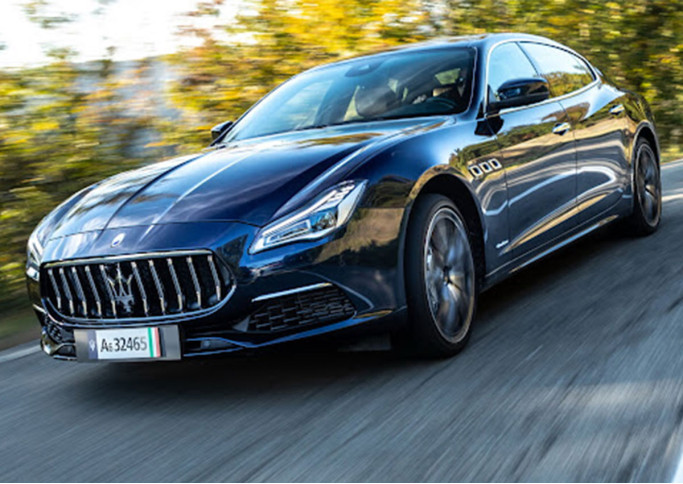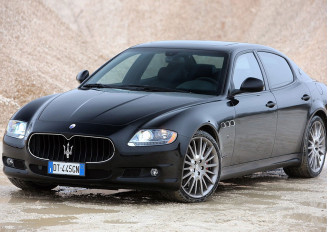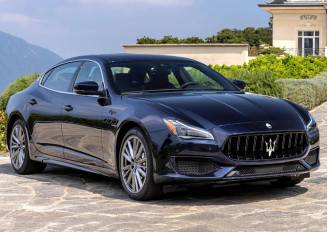Maserati Quattroporte Maintenance Schedule: Professional Standard and Cost Planning
1. Purpose of This Material
This document summarizes verified intervals, operations, and indicative costs for the Maserati Quattroporte (V6/V8, ICE versions across various model years). The goal is to provide the owner with a structured Maserati Quattroporte service plan that can be applied in practice for annual work planning, consumables selection, and monitoring the condition of key assemblies. The information is based on official Maserati programs and typical dealer schedules (12 months / 12–12.5k miles, “accumulative” logic of operations).
2. Principles for Building the Schedule
Dual criterion “time or mileage.” For Maserati Quattroporte maintenance, the guidepost is every 12 months or about 12,000 miles (~19,000 km), whichever comes first. Newer vehicles remind you via the service indicator on the instrument panel.
Accumulative structure of intervals. Each “major” stage includes the list of previous annual work plus additional operations (year 2 — brake fluid/cabin filter; year 3 — spark plugs; year 4 — engine air filter and belts, etc.). This is typical dealer practice for Ghibli/Levante/Quattroporte V6 and is applied to Quattroporte as well.
Adaptation to operating conditions. For short city trips, dusty environments, or frequent cold starts, the intervals are shortened. Recommendations are clarified in the official manual for the specific model year.
3. Consolidated Schedule: Maserati Quattroporte (Overview)
Below is the “backbone” used by dealers and specialized service programs. Verify specifics for your VIN against the owner’s manual and service booklet.
- Every year / ~12,000 miles (~19,000 km) — basic annual service: engine oil and oil filter replacement; inspections of fluids, brakes, tires, suspension, electrical; diagnostics.
- Every 2 years / ~25,000 miles (~40,000 km) — annual package + brake fluid flush and replacement, and cabin filter.
- Every 3 years / ~37,500 miles (~60,000 km) — annual package + spark plug replacement.
- Every 4 years / ~50,000 miles (~80,000 km) — two-year package + engine air filter and belts (condition-based).
- After year 4 — repeat the cycle with adjustments based on the actual condition of assemblies and driving style.
Official Maserati Maintenance programs (Premium and Maintenance 10) cover the first 3 service visits and the intervals from the 4th to the 10th, respectively; this helps lock in future costs.
4. Interval Contents: In Detail
4.1. Annual Interval (12 months / ~12,000 miles)
Scope of work:
- Engine oil (with approvals certified for Quattroporte) and oil filter replacement.
- Checking/adjusting the level of coolant, brake fluid, and washer fluid.
- Inspection of brake mechanisms, hoses, calipers, and connections.
- Visual assessment of leaks, system tightness, and hose condition.
- Inspection of suspension/steering (bushings, joints, shock absorbers), tires (pressure/wear/pull), and lighting.
- Electrical diagnostics (fault scan) and check of belts/idlers.
This is the base package on which subsequent blocks are “layered.” Such a scope is reflected in publicly available dealer schedules for related models; the logic is identical for Maserati Quattroporte maintenance.
4.2. Two-Year Interval (~25,000 miles)
In addition to the annual package:
- Brake fluid flush and replacement (its hygroscopic nature degrades performance and promotes internal corrosion).
- Cabin filter replacement (stable microclimate and clear windows).
4.3. Three-Year Interval (~37,500 miles)
In addition to the annual package:
- Spark plug replacement, observing heat range and gap specified for the particular Maserati Quattroporte variant.
4.4. Four-Year Interval (~50,000 miles)
In addition to the two-year package:
- Engine air filter replacement.
- Inspection/replacement of accessory belts (and idlers as condition dictates).
The goal is to restore intake throughput and minimize the risk of auxiliary component failure due to worn belts.
4.5. 5 Years (~62,500 miles) and Beyond
Repeat the annual work with a focus on actual wear of brakes, suspension, rubber parts and seals; assess noises/vibrations; check battery condition; and update ECU software (as indicated).
5. Additional Assemblies and Fluids: Recommendations for Quattroporte
5.1. Automatic Transmission (AT)
For long-term reliability, preventive ATF renewal at large intervals (~60–65k miles) is advisable, with filter/pan replacement where the specific Quattroporte gearbox design provides for it. This is a common recommendation by specialist workshops even where the strict schedule lists “condition-based.”
5.2. Differentials / Transfer Units
Renew the lubricant about every 50–60k miles in cases of intensive city use or regularly high temperatures.
5.3. Coolant
Check level and density at every annual service; replace based on condition or within “major” windows together with related work.
6. Indicative Costs: Budget Planning
Actual cost depends on region, exchange rates, dealer/independent shop pricing, and the scope of work. Dealer calculators in the U.S. for related Maserati models (an approach identical for Quattroporte) suggest the following benchmarks:
- Annual package (~12k miles): about $736.
- 2 years / 25k miles: approximately $1,931 (including brake fluid and filters).
- 3 years / 37.5k miles: roughly $2,419 (including spark plugs).
- 4 years / 50k miles: roughly $4,165 (adds belts and higher-labor operations).
Costs may vary for Maserati Quattroporte maintenance depending on the variant (V6/V8, Trofeo, etc.), but the relationship “annual < two-year < three-year < four-year” holds in most cases. To lock in expenses, consider Maserati Maintenance Premium (first 3 services) and Maintenance 10 (from the 4th to the 10th).
7. Consumable Standards and Parts Selection
- Engine oil — only with approvals certified for the engine of your Maserati Quattroporte’s model year.
- Filters (oil, air, cabin) — with correct flow capacity and geometry.
- Brake fluid — class per the manual; replacement every 24 months is standard dealer practice.
- Spark plugs — heat range/gap per documentation.
- Belts/idlers — condition-based; replace no later than ~50k miles, together with preventive work on auxiliaries.
8. Preparing for a Service Visit
- Review previous work history and any open recommendations.
- Compile a list of consumables for the planned interval.
- Record symptoms (noises/vibrations, AT behavior, increased stopping distance, rising fuel consumption).
- Agree with the technician on the scope of mandatory work, checks, and budget limits.
- If needed, request the return of removed parts for a visual assessment of actual wear.
9. Examples “Symptom → Action” (Quattroporte)
- Jerks under load, unstable idle: check spark plugs, intake, possible air leaks; perform engine fault diagnostics.
- Pulsation at the brake pedal or increased stopping distance: check disc/pad thickness; brake fluid condition and presence of air in the system.
- Suspension noises on bumps: diagnose mounts, bushings, anti-roll bar links, hub bearings; check alignment if needed.
- AT delays or harsh shifts: scan codes, monitor temperatures, assess fluid condition; consider planned fluid renewal.
10. Insurance and Total Cost of Ownership (Reference)
The average insurance premium for a Maserati Quattroporte in the U.S. is estimated at about $5,135 per year; over 5 years — ~$25,675. This is not a maintenance item, but it is an important part of the ownership budget; costs can be reduced by comparing offers from insurance providers.
11. Frequently Asked Questions (FAQ)
Can I extend intervals if my annual mileage is low?
No. Oil and fluids age over time; keep to annual service even with low mileage. The service indicator provides reminders.
Why do I sometimes see 12,500 miles instead of 12,000?
This is due to local schedules and rounding. A practical guidepost is once a year or ~12–12.5k miles, reflected in dealer schedules for Ghibli/Levante/Quattroporte.
Is ATF replacement mandatory if the manual has no “hard” date?
For Maserati Quattroporte, it’s a recommended preventive action at large intervals (~60–65k miles) that improves shift smoothness and component life.
How can I lock in costs in advance?
Use the official Maintenance Premium (first 3 services) and Maintenance 10 (from the 4th to the 10th). They use genuine parts and standardized work lists per the service book.
12. Concise Summary Plan for the Maserati Quattroporte Owner
- Every year / ~12k miles — oil + oil filter + inspections of chassis, brakes, electrical, and fluids.
- Every 2 years / ~25k miles — + brake fluid (flush) + cabin filter.
- Every 3 years / ~37.5k miles — + spark plugs.
- Every 4 years / ~50k miles — + engine air filter + belts (condition-based).
- AT/differentials at large intervals — per practitioner recommendations (~60–65 / 50–60k miles, respectively).
- To lock in costs — consider Maintenance Premium / Maintenance 10.
13. Parts Selection and Assembling “Service Kits”
To reduce the risk of mismatches and rework, select parts by VIN in line with Maserati specifications for the Maserati Quattroporte. A common practice is to assemble “kits” for a specific interval (12/25/37.5/50k miles): oil and filters, spark plugs, belts/idlers, brake fluid, and associated consumables (seals, washers, clips).
MIE Corporation — Maserati Quattroporte Auto Parts Store.
Address: 615 St. Helens Ave, Tacoma, WA, 98402, USA
We select genuine and OEM-equivalent parts for Maserati Quattroporte maintenance, taking into account model year, engine type, and operating profile; we provide technical notes on work sequence and torque specs.
Conclusion
A systematic approach to Maserati Quattroporte maintenance following the scheme “year/12k miles + accumulative stages at 25/37.5/50k miles” ensures stable operating metrics, predictable costs, and preservation of residual value. Using official service programs and selecting the correct consumables reduces the likelihood of unplanned failures and optimizes total cost of ownership (TCO).








